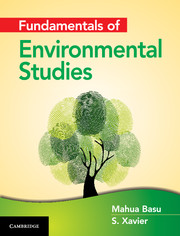Book contents
- Frontmatter
- Dedication
- Contents
- Preface
- Acknowledgments
- 1 Multidisciplinary Nature of Environmental Studies
- 2 Natural Resources – Energy
- 3 Natural Resources – Water, Land, Forest, Food and Mining
- 4 Ecosystems
- 5 Biodiversity and Its Conservation
- 6 Environmental Pollution
- 7 Waste Management
- 8 Disaster and Disaster Management
- 9 Social Issues and Environment
- 10 Human Population and the Environment
- Bibliography
6 - Environmental Pollution
Published online by Cambridge University Press: 06 August 2018
- Frontmatter
- Dedication
- Contents
- Preface
- Acknowledgments
- 1 Multidisciplinary Nature of Environmental Studies
- 2 Natural Resources – Energy
- 3 Natural Resources – Water, Land, Forest, Food and Mining
- 4 Ecosystems
- 5 Biodiversity and Its Conservation
- 6 Environmental Pollution
- 7 Waste Management
- 8 Disaster and Disaster Management
- 9 Social Issues and Environment
- 10 Human Population and the Environment
- Bibliography
Summary
Learning objectives
▄ To know about the different aspects of pollution.
▄ To identify the causes of pollution, to realize the impact of pollution and develop a plan for solution and to set up adequate control measures.
▄ To develop public awareness and to elicit collective and individual response to prevent pollution.
▄ To know about real life situations through case studies and arouse sensitivity.
Introduction
Definition
Pollution can be defined as any undesirable change in the physical, chemical and biological characteristic of air, water or land that may or will harmfully affect human life or that of various species, the industrial processes, living conditions and cultural assets.
Classification of pollutants
Generally a pollutant is classified as biodegradable and non-biodegradable. Biodegradable pollutants are those which degrade easily such as sewage, whereas non-biodegradable pollutants are those which either do not degrade or degrade very slowly, such as plastic.
General source of pollutants
The sources of pollution caused by man-made actions can be grouped under four categories.
▄ Mobile transport: motor cars, motor bikes, aircrafts, ships, vapourization of gasoline.
▄ Stationary/immobile combustion: domestic, business sources, steam power-driven and thermal power plants.
▄ Factories and industry processes: metal and non-metal extractions, paper and pulp, oil refineries, synthetic chemicals, food processing industries.
▄ Disposal of solid wastes: domestic and mercantile refuse, refuse from coal combustion, burning of agricultural refuse.
State of pollution in India
A Comprehensive Environmental Pollution Index (CEPI) is used to typify the quality of the environment at a particular locality ensuing the source of pollution, their path or conduit and the receiver. CEPI is envisioned to function as an instrument of timely warning. Such a pollution index apprehends the well-being of environmental components like air, water and land in their various dimensions. The CPCB or SPCB or Pollution Control Committees in association with IIT Delhi, had applied Central Environmental Pollution index to 88 specific industrial clusters or areas. Out of 88, 43 were ‘critically polluted’ (with score more than 70 out of 100); 32 were ‘severely polluted’ with scores varying between 60 and 70. In the interim assessment report carried out jointly by CPCB and GPCB, 2012, Vapi ranked first in pollution with a CEPI score of 90.75 out of 100, Angul Talcher ranked second with 89.74, while Vatva and Ankleshwar rank sixth and seventh respectively.
- Type
- Chapter
- Information
- Fundamentals of Environmental Studies , pp. 208 - 269Publisher: Cambridge University PressPrint publication year: 2015
- 1
- Cited by



